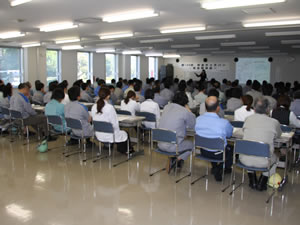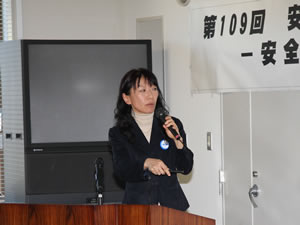
|
|
During the Safety Presentation
|
The session was attended by 108 Genkai Nuclear Power Station employees and employees from affiliated companies.
Mr. Shinichiro Nakata, general manager of Genkai Nuclear Power Station No. 2 Unit, gave the opening address prior to the main presentation.
“Everyone gathered here today is engaged in fostering a safety culture with the objective of creating a safe worksite where good communications and a good workplace atmosphere are paramount. This feeling is shared equally by the employees of Kyushu Electric Power and the employees of our affiliates. And yet when we examine the reality of our operations, we find a vast range of errors, from mundane mistakes in keeping records or transcriptions to profound errors that can shut down a power plant. We recognize, then, the extreme difficulty of eradicating all errors. Today, we have been fortunate to set aside time to hear directly from a safety expert. As you listen, please consider how today’s presentation can be applied to your own routine behavior. I hope, by this means, that this session will prove beneficial in our ongoing safety efforts.”
Following the opening address, Ms. Yuki Shuto, director and deputy general manager of the Research Institute for Social Safety, gave a presentation entitled “What is Safety Culture?: Constructing a safety culture that heads off human error.” |

|
|
Ms. Yuki Shuto,
director and deputy general manager
of the Research Institute for Social Safety
|
The main points of Ms. Shuto’s beneficial presentation are as follows:
•The importance of organizational safety culture was pointed out in the wake of the Chernobyl disaster. This concept — that safety is more important than everything else — has been interpreted to mean that safety must be positioned as a value diametrically opposed to profitability, productivity, and efficiency in order to ensure that priority is not put on profits to safety’s detriment. Yet, this interpretation rings hollow to rank-and-file plant workers, who already believe they put safety first at all times and are certain they would never compromise safety for efficiency. So although they grasp the importance of safety culture, this interpretation has many workers wondering what they should be doing specifically to implement the concept.
•On hearing these criticisms from the workplace, an innocent but valid question comes to mind: Is safety really a value at odds with profitability and efficiency? In fact, when we comb through past safety incidents caused by organizational safety culture flaws, we find we cannot necessarily lay the blame on people putting profits ahead of safety. Instead, we discover that what is at fault in these safety incidents is a deviation from normalcy: that is, a gradual loss of strict adherence to established practices and rules.
• “Violations” is a relatively new concept in human error classification that describes situations in which people act contrary to established practices. But although recognition of the importance of resolving this behavior has spread widely in recent years, ironing out behavioral violations is no easy task. Despite efforts in many different fields, we have yet to establish systematic methodologies in this area.
•Nevertheless, I can present a couple of specific examples of efforts underway in the aviation industry and the chemical industry. The aim of these efforts is to build a workplace environment where workers enjoy obeying the rules. These efforts generally refer to a four-step approach: (1) create “good” rules, (2) disseminate and instill the rules, (3) continually check compliance, and (4) offer appropriate rewards and punishments based on compliance reviews.
Some comments from the audience survey taken after the presentation.
•I was very taken by the idea of behavioral rules and etiquette that you acquire naturally. In the end, I think safety is something that comes down to each and every individual.
•I think a good future challenge will be the positive take on being playful and mischievous from the four-step approach to rules to prevent behavioral violations.
•I recognized that we nuclear plant workers have “safety-first” in mind as we go about our tasks. But hearing about how the JCO incident happened made me realize that I have to revisit (rethink) my own ideas through the lens of actual workplace operations. I recalled many similarities in my work with the Challenger disaster and I feel I need to reconsider my future approach. It was a very meaningful presentation for me.
•The examples from organizations that have very few accidents are extremely useful references for me as someone who is engaged in operations at a nuclear power plant. This will be a help, in comparison to the situation at our plant, in broadening the improvement and penetration of a safety consciousness.
•I recognized from this presentation that safety culture does not conflict with economics or efficiency improvements, and I recognized the importance of designing normal work operations to put safety at the heart of everyday behavior. To achieve this, I think it is critical that there is good communication and information sharing throughout the company, from the top of the organization to the work floor.
•I’ve frequently heard the term “safety culture” but I never really had a clear image of what it was. But hearing several detailed examples was an extremely intriguing lesson for me.
•I’ve always dedicated myself to working safely, but I think I’ll change my way of thinking after hearing here about creating rules that can be followed rather than the old stereotype that rules that must be followed.
|
At the safety information exchange session, Mr. Seiji Anzai — in charge of operational management and operational technology at the operation management department of TEPCO’s Fukushima Daini Nuclear Power Station — gave a presentation on management observations by operational and administration departments; Mr. Hideaki Morohashi — safety management group manager at the quality and safety management department of TEPCO’s Fukushima Daini Nuclear Power Station — gave a presentation on efforts related to fostering a safety culture; Mr. Michiharu Matsuzaki — deputy manager of technology division No. 2 at Kyushu Electric Power’s Genkai Nuclear Power Station — gave a presentation on Kyushu Electric Power’s human factors initiatives; and Mr. Kazutoshi Eto — manager of the safety and quality assurance office No. 2 at Kyushu Electric Power’s Genkai Nuclear Power Station— gave a presentation on Kyushu Electric Power’s initiatives to foster a safety culture.
Following the presentations, the attendees exchanged information and opinions on these activities and initiatives. |







